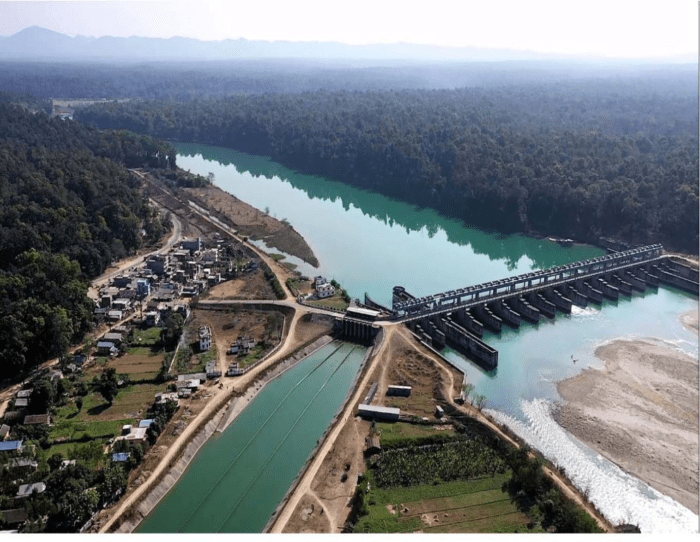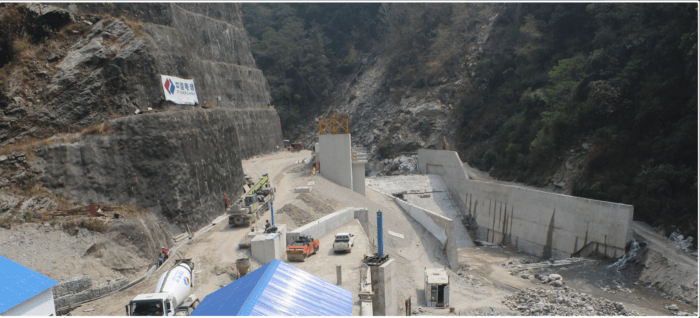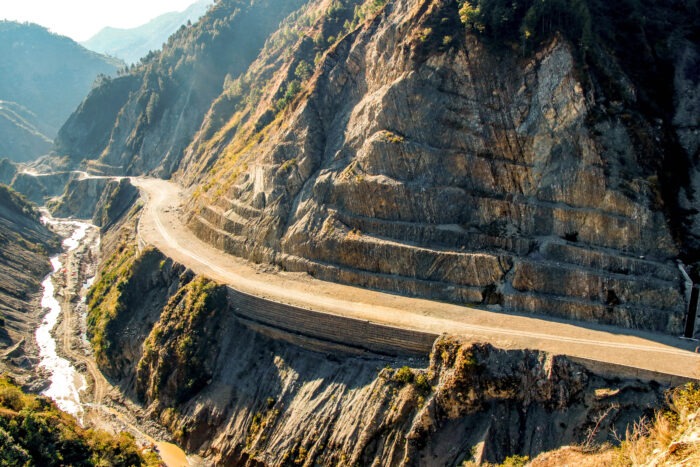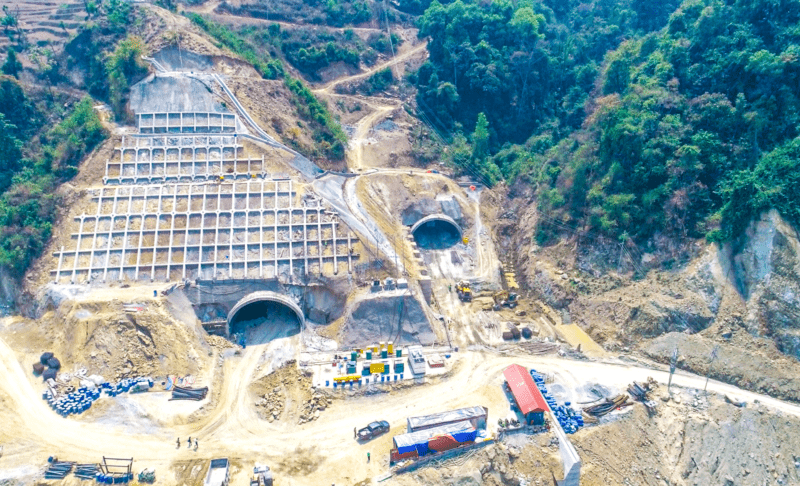Deadlines? Only a few national projects in Nepal seem to recognize this term. Despite most national projects being completed long after their initial deadlines, they have significantly transformed the Nepalese economy in their own unique ways. Whether it’s the largest hydropower plants, express highways, or irrigation projects, these feats of engineering and innovation have dramatically improved the lives of millions of Nepalese people. They have directly or indirectly paved the way for a new era of infrastructural development, preparing Nepal to launch itself onto the global stage.Here are some of the development projects of Nepal in 2024 that aim to change the economical status of Nepalese in coming decades.
Let’s delve deeper into why these projects have become an integral pillar in revolutionizing the Nepalese economy:
- Upper Tamakoshi Hydropower Project
- Babai Irrigation Project
- Sikta Irrigation Project
- Sunkoshi Marin Diversion
- Melamchi Water Supply Project
- Kathmandu Terai Express Way
1. Upper Tamakoshi Hydropower Project


Overview
The Upper Tamakoshi Hydropower Project (UTKHEP) is a national priority project and the largest hydroelectric plant in Nepal under operation. Established in March 2007 (2063/11/25 B.S.) by the Nepal Electricity Authority (NEA) through its autonomous company, Upper Tamakoshi Hydropower Limited (UTKHPL), the project is crucial for Nepal’s energy sector, providing a significant boost to the country’s electricity generation capacity.
Project Components
- Type of Development: Peaking Run-of-River (PRoR)
- Location: Bagmati Province, Dolakha District, Bigu Rural Municipality Ward No. 1
- Headworks Location: Lamabagar
- Powerhouse Location: Gongar Gaon
- Maximum Output: 456 MW
- Annual Energy Generation: 2,281 GWh
- Catchment Area: 1,745 km²
- Mean Annual Flow: 67.2 m³/sec
- Diversion Dam: 22m x 60m (H x L)
- Live Storage: 1.2 million m³
- Headrace Tunnel: 8.4 km (Cross-sectional area: 32.14 m²)
- Penstock (Vertical Shaft and Horizontal Tunnel): 1,134 meters
- Transmission Line: 220 kV Double Circuit, 47 km (Gongar to Khimti Substation)
- Construction Cost: NRs. 35.29 billion (US$ 441 million, excluding Interest During Construction)
- Construction Time Period: 6 years
Shareholding Structure
- Major Shareholders:
- Nepal Electricity Authority (NEA): 41%
- Nepal Telecom (NTC): 6%
- Citizen Investment Trust (CIT): 2%
- Rastriya Beema Sansthan (RBS): 2%
- General Public and Residents of Dolakha District: 25% (15% general public, 10% residents)
- Other Stakeholders: Employees Provident Fund (EPF), NEA & company staff, and financial institutions’ staff: 24%

History and Development
- 1985: Identified as ‘TA-6’ project by Japan International Cooperation Agency (JICA) during Koshi Basin Water Resources Development Master Plan.
- 1999: Pre-feasibility studies conducted by Austrian consultant Christian Ulhar, indicating a 120 MW capacity.
- 2001: NEA conducted the first stage detailed feasibility study, showing a 250 MW capacity and 1570 GWh annual energy generation.
- 2003: Detailed engineering design of a 28.5 km access road and seven bridges completed.
- 2005: Bankable Detailed Design Feasibility Study by Norwegian consultant Norconsult AS, showing a capacity of 309 MW and 1737 GWh annual energy generation.
- 2006: Establishment of Upper Tamakoshi Hydropower Limited.
- 2007: Project implementation began, targeting a 456 MW capacity and 2281 GWh annual energy generation.
- 2022: UTKHEP commenced operations.
2. Babai Irrigation Project


Overview
The Babai Irrigation Project aims to provide irrigation to approximately 36,000 hectares of agricultural land in Bardiya District. Initiated in 1967 (2024 B.S.), the project has undergone various phases of studies and construction to enhance irrigation infrastructure in the region.
General Information
- Objective: Provide irrigation to approximately 36,000 hectares in Bardiya District.
- Initiation: Studies began in 1967 (2024 B.S.) with the involvement of the International Development Association (IDA).
Initial Studies and Feasibility
- Pre-Feasibility Study: Conducted with UNDP financial support, identifying 19,000 hectares east and 21,000 hectares west of Babai River as irrigable.
- First Phase Feasibility: Completed in 1978 (2035 B.S.) for 13,240 hectares to the east.
- Detailed Engineering Design: Completed between 1981 and 1983 (2038 to 2040 B.S.) with IDA loan assistance, proposing a siphon in Babai River.
Project Components
- Main Canal Construction:
- East: 34 km
- West: 41 km
- Jamuni-Bargada: 16 km
- Total: 91 km
- Branch/Sub-Branch/Distributary Canals: 313 km
- Canal Structures:
- Eastern Main Canal:
- 41 Valve Regulated Bridges (VRB)
- 32 Direct Upstream Pumping (DUP) structures
- 27 Pumping Under Pressure (PUP) structures
- 14 Canal Under Pressure (CUP) structures
- 2 Aqueducts
- 3 Escapes
- 5 Spillways
- Western Main Canal:
- 24 Valve Regulated Bridges (VRB)
- 3 Direct Upstream Pumping (DUP) structures
- 1 Pumping Under Pressure (PUP) structure
- 3 Canal Under Pressure (CUP) structures
- 1 Aqueduct
- 3 Escapes
- 2 Spillways
- Eastern Main Canal:
- Development and Expansion: 32 km of irrigated area.
- Other Works: Drainage and service road construction.

Implementation Phases
- First Phase Construction:
- Weir cum Bridge: Completed in 1992 (2049 B.S.) at NPR 679.5 million.
- Main Canal: Initial 5.5 km section completed in 1993 (2050 B.S.), irrigating about 4,000 hectares via traditional canals (Budhi Kulo, Majhara Kulo, Rajkulo, Dhadawar Kulo).
- Further Construction: 22.5 km of the remaining 28 km of Babai main canal completed by 2001 (2058 B.S.).
- Second Phase Planning and Construction:
- Detailed Engineering Design: Completed in 2001 (2058 B.S.) by East Consult Pvt. Ltd-BDA Nepal Pvt. Ltd. JV.
- Siphon and Canal Structures: Construction started in 2010/11 (2067/68 B.S.) and targeted for completion by 2012/13 (2069/70 B.S.) at NPR 442.4 million. Structures were damaged by floods in 2014 (2071 Shrawan) and rebuilt by June 2016 (2073 Ashad).
Area and Financial Details
- Irrigable Area: Confirmed as 36,000 hectares (21,000 hectares east, 15,000 hectares west) by Bheri Babai Diversion Multipurpose Project in 2012.
- Master Plan: Approved on May 4, 2021 (2078.01.21 B.S.) with a budget of NPR 18.963 billion, targeting completion by fiscal year 2025/26 (2082/83 B.S.).
- Expenditure: By fiscal year 2022/23 (2079/80 B.S.), NPR 12.2894 billion had been spent.
3. Sikta Irrigation Project


Introduction
A 317-meter-long barrage has been constructed on the Rapti River at Agaiya in Rapti Sonari Rural Municipality, Banke District, Lumbini Province. This construction aims to provide reliable irrigation to 42,766 hectares of land across six rural municipalities, Kohalpur Municipality, and Nepalgunj Sub-Metropolitan area within the district. The Sikta Irrigation Project, initiated in fiscal year 2062/63 by the Government of Nepal using its own resources, includes a command area of 33,766 hectares on the western side and 9,000 hectares on the eastern side of the Rapti River.
Background
- Initial Proposal: Proposed as the West Rapti Multipurpose Project in the Pre-Feasibility Study (1975-1976).
- Early Studies:
- Pre-feasibility study conducted in 1975 (2032 B.S.) by a German consulting firm with UNDP and ADB assistance.
- Feasibility study report submitted in 1980 (2036 B.S.).
- Project found feasible, but Asian Development Bank (ADB) declined financial assistance due to lack of consent from India.
- Re-Feasibility and Feasibility Studies:
- Re-feasibility study by Regional Irrigation Directorate in 1983 (2040 B.S.).
- Final feasibility study in 2002 (2059 B.S.) with EU financial support, recommending implementation due to technical and financial feasibility.
- Estimated Cost: Initially estimated at NPR 7.45 billion, with a seven-year implementation period.
- Funding Attempts: Efforts to secure financial support from the European Union, Saudi Fund for Development, Kuwait Fund, and OPEC Fund were unsuccessful.
Project Implementation
- Internal Funding: Due to lack of external financial assistance, the Government of Nepal funded the project internally.
- Master Plan Approval:
- Approved on 2064/08/03 with a budget of NPR 12.8 billion for completion by fiscal year 2070/071.
- Revised master plan in fiscal year 2071/72 with a budget of NPR 25.02 billion to include an additional 9,000 hectares on the eastern side.
- Current Cost and Timeline:
- Revised cost estimate of NPR 52.64 billion.
- Completion targeted by fiscal year 2089/90, approved in 2079 Bhadra by the Ministry of Energy, Water Resources, and Irrigation.
Project Impact
- Beneficiaries: Expected to benefit 17,000 households and 400,000 farmers in the district.
- Internal Rate of Return: Estimated at 18%.
- Crop Density: Expected to increase from 168% to 242%.
Main Works Completed
- Headworks: Civil and hydro-mechanical works.
- West Main Canal: 45.25 km.
- Land Acquisition: 110.55 hectares.
- West Main Canal Branches:
- Akalgharwa: 4.6 km
- Gohwa: 2.05 km
- Prasenipur: 4.6 km
- Pidari: 4.1 km
Ongoing Works for Fiscal Year 2079/080
- Shidhaniya Branch: 5.2 km to 6.0 km under construction, to be completed in the current fiscal year.
- East Main Canal: Started in fiscal year 2074/75.
- Concrete structure up to 37+675 chainage.
- Earthen canal up to 44+900 chainage.
- Branch canals (Rajkulo, S1, S2, S3, S4, and Phattepur) to be completed by February.
- Command Area Protection Works: Ongoing in various locations.
- Environmental Impact Assessment and Prevention Works.
- Land Acquisition: For the main canal, branch, and distributary canals.
Conclusion
The Sikta Irrigation Project is a significant initiative aimed at enhancing agricultural productivity and providing reliable irrigation facilities to a vast area in Banke District. Despite initial setbacks in securing external funding, the project has progressed substantially with internal resources and is expected to significantly benefit local farmers and contribute to the region’s overall development.
4. Sunkoshi Marin Diversion

Overview
The Sunkoshi Marin Diversion Multipurpose Project (SMDMP) is designated as one of Nepal’s National Pride Projects. The project, managed by the Ministry of Energy, Water Resources, and Irrigation, was granted National Pride status on January 20, 2020.
Objectives
- Inter-Basin Water Transfer: The primary goal is to transfer water from the Sunkoshi River to the Marin Khola, a tributary of the Bagmati River.
- Irrigation: This transfer will support the Bagmati Irrigation System, irrigating an additional 122,000 hectares of land across the districts of Rautahat, Dhanusha, Mahottari, Sarlahi, and Bara.

Technical Specifications
- Design Flow: 67 cubic meters per second (m³/s).
- Diversion Dam: A 12-meter-high dam on the Sunkoshi River facilitates the water intake.
- Tunnel: Water is transferred through a 13.3 km long tunnel.
- Power Generation: The project includes a power station with a capacity of 31.07 MW, located in Kamalamai Municipality.
Significance
- Agricultural Enhancement: By providing irrigation to a vast area, the project aims to boost agricultural productivity and support local economies in multiple districts.
- Energy Production: The hydroelectric component contributes to Nepal’s energy resources, promoting sustainable energy development.
5. Melamchi Water Supply Project (MWSP)


Overview
The Melamchi Water Supply Project (MWSP) is designed to alleviate the chronic water shortage in the Kathmandu Valley by diverting about 170 million liters per day (MLD) of fresh water from the Melamchi River in Sindhupalchowk district. Additionally, future plans include augmenting this supply with an additional 170 MLD from the Yangri and Larke rivers.
Agencies
- Executing Agency: Ministry of Physical Planning and Works (MPPW).
- Implementing Agency: Melamchi Water Supply Development Board.
Funding and History
- Initiation: Began in 1998.
- Major Donor: Asian Development Bank (ADB) approved Loan 1820-NEP (SF) in 2000.
- Funding Shortfall: Loss of support from World Bank, NORAD, and SIDA, creating a $133 million shortfall.
- Restructured Cost: Revised total of $317.3 million with completion targeted for June 2013.
- Current Donors: ADB, JBIC, JICA, NDF, OPEC, Government of Nepal.

Project Components
Part A: Melamchi Valley Subproject
- Melamchi Diversion Scheme: 170 MLD of water via a 26.0 km tunnel.
- Infrastructure: 43 km of access roads, 29 km road upgrades, and a water treatment plant with initial 170 MLD capacity.
- Social Upliftment: Buffer zone development, rural electrification, health, education, and income generation.
Part B: Kathmandu Valley Subproject
- Water Distribution Network: Rehabilitation and improvement at various levels, house connections, and existing system upgrades.
- Bulk Distribution System: Service reservoirs and bulk water pipelines.
- Waste Water System: Phased improvements.
- Ground Water Well Field: Development at Manohara to extract, treat, and distribute 20 MLD of water.
Part C: Project Support
- Resettlement Action Plan: Development and implementation.
- Environmental Management Plan (EMP): Hygiene education, public relations, social and environmental monitoring, groundwater monitoring.
- Project Administration Support: PMU operations, design and construction supervision, social and environmental activities, training, and incremental administration costs.
Donor Contributions
- ADB: $103.8 million.
- JBIC/JICA: $47.5 million.
- NDF: $10.5 million.
- OPEC: $13.7 million.
- Government of Nepal: $73.9 million.
6. Kathmandu-Terai Expressway


The Kathmandu-Terai/Madhesh Fast Track Expressway, also known as simply “Fast Track,” is a major infrastructure project currently under construction in Nepal. Here’s a breakdown of its key details:
- Purpose: Connect Kathmandu, the capital city, to Nijgadh in the southern Terai region, also acting as the gateway for the upcoming construction of Nijgadh International Airport with the capital city.
- Project Location: Starting Point Km. 0.0 of Khokana (Kathmandu) – End Point Km 72.50 of Nijgadh at the E-W Highway Junction.
- Category of Road: Primary Class (Asian Highway Design Standard 1993).
- Level of Services (LOS): A.
- Length: Approximately 72.50 Kilometers (45.049 miles).
- Travel Time: 1 hour 2 minutes.
- Components:
- 55.489 kilometers (34.479 miles) of regular roadway.
- 10.596 kilometers (6.584 miles) of bridges.
- Total Number of Bridges: 87.
- 6.415 kilometers (3.986 miles) of tunnels (including six tunnels in total).
- Clear Height: 5.5 m.
- Width: 9.5 m.
- Twin Tunnel:
- Length 3.355 Km at Mahadev Dada.
- Length 1.630 Km at Dhedre Dada.
- Length 1.430 Km at Lane Dada.
- Construction: Undertaken by the Nepali Army.
- Construction Period: 4 Years 6 Months.
- Benefits: Expected to significantly reduce travel time between Kathmandu and the south, potentially by up to 159 kilometers compared to existing routes.
- Timeline:
- Original completion target: September 2021.
- Revised target completion date: April 2027 (as of October 2023).
- Progress as of July 2021: Approximately 16.1% complete.

Current Status (as of May 24, 2024):
- Construction is ongoing, with a reported progress of around 27.19% achieved.
- The project aims for completion by the revised deadline of April 2027.
Conclusion
Through innovative projects and strategic investments, Nepal’s economy is undergoing a profound transformation. These initiatives are not only enhancing infrastructure but also fostering sustainable growth and socio-economic empowerment. With continued dedication to development, Nepal is poised to unlock its full potential and emerge as a thriving economic powerhouse in the region.
